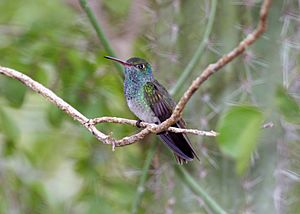Honduran emerald facts for kids
Quick facts for kids Honduran emerald |
|
|---|---|
 |
|
| Conservation status | |
| Scientific classification | |
| Genus: |
Amazilia
|
| Species: |
luciae
|
The Honduran emerald (Amazilia luciae) is a beautiful hummingbird that lives only in Honduras. It's called an "emerald" because of its bright green feathers. Sadly, this special bird is a Vulnerable species, which means it needs our help to survive.
Contents
About the Honduran Emerald
Have you ever wondered how animals get their names? The Honduran emerald was first described in 1868 by an American bird expert named George Newbold Lawrence. He named it Amazilia luciae to honor Lucy Brewer, the daughter of another bird expert, Thomas Mayo Brewer.
What Does It Look Like?
The Honduran emerald is a small bird, about 9 to 10 centimeters (3.5 to 4 inches) long. Both male and female birds have a medium-sized beak that curves down a little. The top part of the beak is black, and the bottom part is red with a black tip.
Adult male Honduran emeralds have a dark green head and back. This green color turns a bit bronze on their lower back and tail feathers. Their central tail feathers are dark green, while the others are dark green with a purplish band near the end. Their throat and upper chest are a pretty blue color, which can sometimes look greenish or grayish. Their lower chest is grayish-white with green sides.
Female birds look similar to males but are a bit duller in color. Their blue throat patch is smaller and greener. Young birds look a lot like the females.
What Does It Sound Like?
The Honduran emerald makes several interesting sounds. One common call is a "hard, slightly metallic ticking call," which it often repeats like "chik, chik-chik, chik chik..." When it flies, it sometimes makes a "hard, slightly buzzy chattering" sound, like "zzchi ---" or "chik chi zzhi ---." It also has a quiet, dry warbling sound, which might be its song, and a sharp "siik" sound when chasing other birds.
Where Does It Live?
The Honduran emerald lives in three separate areas in northern Honduras. These areas are in the departments of Santa Bárbara, Cortés, Yoro, and Olancho. For a long time, people didn't see many of these birds. But since 1988, and especially since 2007, they've been spotted more often in these areas.
Its Home Environment
This hummingbird prefers to live in tropical dry forests. These forests are usually found in valleys between mountains. The trees are often not too tall, and the forest canopy (the top layer of leaves) can be open or partly closed. In some areas, the forests are taller and denser, with trees that lose their leaves in certain seasons.
The Honduran emerald has also been seen in thorn forests, pine-oak forests, and even at the edges of pastures. In the western parts of its range, it tends to live on valley slopes at elevations between 200 and 500 meters (about 650 to 1,640 feet). In the eastern parts, it lives on the valley floors, also at similar elevations. The landscape in these areas can change a lot, making it tricky to know exactly what kind of habitat this bird likes best.
How It Behaves
Feeding Habits
The Honduran emerald loves to drink nectar from many different kinds of flowers. It looks for nectar at all levels of the forest, from the ground to the treetops. Scientists have found that it drinks nectar from at least 22 different plant species. These include cacti, thorny bushes, trees, vines, and other plants.
In the western part of its home, its main food source is a plant called Helicteres guazumaefolia, which flowers all year. In the east, it seems to prefer Pedilanthus camporum and Nopalea hondurensis. Sometimes, these hummingbirds will even defend their favorite flower patches from other birds. Besides nectar, the Honduran emerald also eats small arthropods, like tiny insects.
Life Cycle
Scientists have found one nest of the Honduran emerald. It was built from soft seed fluff and dried leaves, held together with spiderwebs. The outside of the nest had lichen on it, which helped it blend in. This nest was found about 2.3 meters (7.5 feet) high in a Eugenia lempana tree. Not much else is known about how these birds raise their young.
Conservation Status
The Honduran emerald is currently listed as a Vulnerable species by the IUCN. This means it's at risk of becoming endangered. Over the years, its status has changed as we've learned more about where it lives. Even though we know more now, its home range is still very small and broken up into separate areas.
Scientists believe there are between 10,000 and 20,000 adult Honduran emeralds, and their numbers are decreasing. The biggest threat to these birds is the loss of their habitat. People are cutting down forests to make room for farms and homes. The American Bird Conservancy estimates that about 90 percent of the original habitat for this bird has already been lost. This organization has helped create and expand a protected area in the Aguan Valley to help save this special hummingbird.
See also
 In Spanish: Colibrí esmeralda de Honduras para niños
In Spanish: Colibrí esmeralda de Honduras para niños


